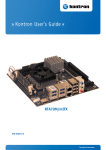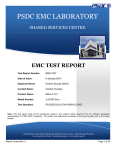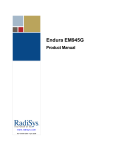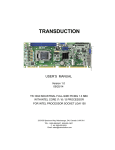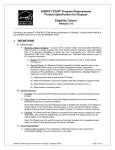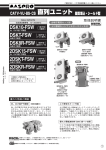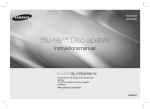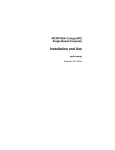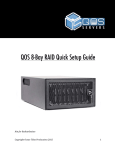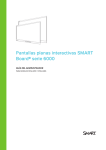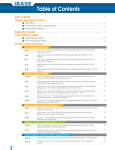Download Kontron User`s Guide
Transcript
PRELIMINARY KTA75/Flex KTD-N0876-0 The pulse of innovation Error! Use the Home tab to apply Überschrift 1 to the text that you want to appear here. Table of Contents » Table of Contents « 1 Introduction ........................................ 5 2 Installation Procedure .............................. 6 2.1 Installing the Board ................................................. 6 2.2 Requirements IEC60950 ................................................ 7 3 System Specifications ............................... 8 3.1 Component main data .................................................. 8 3.2 KTA75/Flex Block Diagram ............................................ 14 3.3 USB ports overview .................................................. 15 4 Connectors Locations ............................... 18 4.1 KTA75/Flex Topview .................................................. 18 5 Connector Signal Definitions ....................... 19 6 Rear IO Connectors ................................. 20 6.1 DisplayPort (DP0/DP1/DP2)( J3/J4/J44) ............................... 20 6.2 USB3.0 Connectors (USB10/USB11/USB12/USB13)(J15/J15/J14/J14) ........ 23 6.3 Ethernet Connectors (ETH1/ETH2) (J8) ................................ 25 6.4 USB x4 Stack Connector (USB6/USB7/USB8/USB9) (J20) .................. 26 6.5 Audio Interface (J40) ............................................... 28 7 Pin Connectors ..................................... 29 7.3 Audio Header Connector (J41) ........................................ 31 7.4 USB4/5 Connector (J16) .............................................. 32 7.5 Jumper area (J34, J35, J36, J37) .................................... 34 7.6 SPI Connector (J21) ................................................. 35 7.7 COM1/COM2 (J23/J22) ................................................. 36 7.8 LPC Connector (J29) ................................................. 37 7.9 Front Panel Connector (J5) .......................................... 38 7.10 CPU/System Fan Connectors (J25, J24) ................................ 40 7.11 Feature Connector (J26) ............................................. 41 7.12 KBD/MSE (J27) ....................................................... 46 8 Slot Connectors (PCI-Express, miniPCIe, PCI, SATA, mSATA) .................................................. 47 8.1 PCIex16 (in x16 slot) (J7) .......................................... 47 8.2 PCIex4 8.3 mPCIe connector (J38) ............................................... 51 8.4 mSATA/mPCIe Connector (J43) ......................................... 52 (J6) ........................................................ 49 KTA75/Flex Users Guide Error! Use the Home tab to apply Überschrift 1 to the text that you want to appear here. Table of Contents 8.5 PCI slot connectors (J18 & J28) ..................................... 53 8.6 J39) SATA0, SATA1, SATA2, SATA3, SATA4 & SATA5 (J12, J13, J9, J11, J10 & 57 Appendix: Mating Connectors ............................. 58 Appendix: OS Setup ...................................... 59 KTA75/Flex Users Guide KTD-N0876-0 Page 1 General Information Document Revision History Rev. Date By 0 Mar 21th 2013 MLA Comment Preliminary version ofKTA75/Flex. Copyright Notice Copyright 2013, KONTRON Technology A/S, ALL RIGHTS RESERVED. No part of this document may be reproduced or transmitted in any form or by any means, electronically or mechani- cally, for any purpose without the express written permission of KONTRON Technology A/S. KTA75/Flex Users Guide KTA75/Flex Users Guide KTD-N0876-0 Page 2 General Information Trademark Acknowledgement Brand and product names are trademarks or registered trademarks of their respective owners. Disclaimer KONTRON Technology A/S reserves the right to make changes without notice to any product, including circuits and/or software described or contained in this manual in order to improve design and/or performance. Specifications listed in this manual are subject to change without notice. KONTRON Technology assumes no responsibility or liability for the use of the described product(s), conveys no license or title under any patent, copyright or mask work rights to these products and makes no representations or warranties that these products are free from patent, copyright or mask work right infringement unless otherwise specified. Applications that are described in this manual are for illustration purposes only. KONTRON Technology A/S makes no representation or warranty that such application will be suitable for the specified use without further testing or modification. Life Support Policy KONTRON Technology’s PRODUCTS ARE NOT FOR USE AS CRITICAL COMPONENTS IN LIFE SUPPORT DEVICES OR SYSTEMS WITHOUT EXPRESS WRITTEN APPROVAL OF THE GENERAL MANAGER OF KONTRON Technology A/S. As used herein: Life support devices or systems are devices or systems which (a) are intended for surgical implant into body or (b) support or sustain life and whose failure to perform when properly used in accordance with instructions for use provided in the labelling can be reasonably expected to result in significant injury to the user. A critical component is any component of a life support device or system whose failure to perform can be reasonably expected to cause the failure of the life support device or system or to affect its safety or effectiveness. KTA75/Flex Users Guide KTA75/Flex Users Guide KTD-N0876-0 Page 3 General Information KONTRON Technology Technical Support If you have questions about installing or using your KONTRON Technology Product, then check this User’s Manual first – you will find answers to most questions here. To obtain support please contact your local Kontron Sales Partner or Kontron Field Application Engineer (FAE). Before Contacting Support: information as possible: CPU Board Please KTA75/Flex be prepared to P/N: provide as much 66110000 1. Type and P/N (Part Number), find label like: Prod.code:A4Q S/N: 01148401 2. S/N (Serial Number), find label like: Configuration (if relevant) 1. CPU Type and Clock speed 2. DRAM Type and Size. 3. BIOS Revision (find the version info in the BIOS Setup Menu). 4. BIOS Settings different than Default Settings. System (if relevant) 1. OS (Operating System) Make and Version. 2. Driver Version numbers: Graphics, Network, and Audio etc. 3. Attached Hardware: Harddisks, CD-Rom, Display Panels etc. KTA75/Flex Users Guide KTA75/Flex Users Guide KTD-N0876-0 Page 4 General Information Warranty KONTRON Technology warrants its products to be free from defects in material and workmanship during the warranty period. If a product proves to be defective in material or workmanship during the warranty period KONTRON Technology will, at its sole option, repair or replace the product with a similar product. Replacement Product or parts may include remanufactured or refurbished parts or components. The warranty does not cover: 1. Damage, deterioration or malfunction resulting from: A. Accident, misuse, neglect, fire, water, lightning or other acts of nature, unauthorized product modification or failure to follow instructions supplied with the product. B. Repair or attempted repair by anyone not authorized by KONTRON Technology. C. Causes external to the product, such as electric power fluctuations or failure. D. Normal wear and tear. E. Any other causes which does not relate to a product defect. 2. Removal, installation and set-up service charges. Exclusion of damages: KONTRON TECHNOLOGY LIABILITY IS LIMITED TO THE COST OF REPAIR OR REPLACEMENT OF THE PRODUCT. KONTRON TECHNOLOGY SHALL NOT BE LIABLE FOR: 1.DAMAGE TO OTHER PROPERTY CAUSED BY ANY DEFECTS IN THE PRODUCT, DAMAGES BASED UPON INCON- VENIENCE, LOSS OF USE OF THE PRODUCT, LOSS OF TIME, LOSS OF PROFITS, LOSS OF BUSINESS OPPORTUNITY, LOSS OF GOODWILL, INTERFERENCE WITH BUSINESS RELATIONSHIPS OR OTHER COMMERCIAL LOSS, EVEN IF ADVISED OF THEIR POSSIBILITY OF SUCH DAMAGES. 2. ANY OTHER DAMAGES, WHETHER INCIDENTAL, CONSEQUENTIAL OR OTHERWISE. 3. ANY CLAIM AGAINST THE CUSTOMER BY ANY OTHER PARTY. KTA75/Flex Users Guide KTA75/Flex Users Guide KTD-N0876-0 1 Page 5 Introduction Introduction This manual describes the KTA75/Flex family of boards made by KONTRON Technology A/S. These board will also be denoted KTA75 within this Users Guide. The KTA75 is designed to support the listed APU variants (uPGA 722pin processors) and AMD A75 Fusion Controller Hub (FCH) A75 on a Flex form factor. See the chapter System Specifications for more specific details. APU variants AMD PN Processor data R-464L RE464LDEC44HJE 2.3 GHz – Quad Core – 35W R-460H RE460HDEC44HJE 1.9 GHz – Quad Core – 35W R-272F RE272FDEC23HJE 2.7 GHz – Dual Core – 35W R-268D RE268DDEC23HJE 2.5 GHz – Dual Core – 35W The 4 versions have the same type of active CPU cooler (the cooler is by default not premounted, but can be ordered with this obtion). Use of this Users Guide implies a basic knowledge of PC-AT hard- and software. This manual is focused on describing the KTA75 board’s special features and is not intended to be a standard PC-AT textbook. New users are recommended to study the Installation Procedure stated in the following chapter before switching-on the power. All configuration and setup of the CPU board is either done automatically or manually by the user via the BIOS setup menus. Only exceptions are the Clear CMOS jumper and the Always On jumper. KTA75/Flex Users Guide KTA75/Flex Users Guide KTD-N0876-0 2 Page 6 System Specifications Installation Procedure 2.1 Installing the Board To get the board running, follow these steps. If the board shipped from KONTRON has already components like RAM mounted, then relevant steps below can be skipped. 1. Turn off the PSU (Power Supply Unit) ! Warning: Turn off PSU (Power Supply Unit) befor configuring the board and do not hot plug power supply, otherwise components (RAM, LAN cards etc.) might get damaged. 2. Insert the DDR3 UDIMM 240 Pin module(s) Be careful to push it in the slot(s) before locking the tabs. 3. Connecting Interfaces and PSU Insert all external cables for hard disk, keyboard etc. A display/monitor must be connected in order to be able to change BIOS settings. Connect a standard ATX/BTX PSU to the board by the inserting power cables into 24-pin ATX and the 4-pin ATX+12V PWR plugs connectors. 4. Power Button Turn on mains power to the PSU. If board doesn’t boot, then PWRBTN_IN must be toggled; this is done by shorting pins 16 (PWRBTN_IN) and pin 18 (GND) on the FRONTPNL connector (see Connector description), by use of a “normally open” switch etc. 5. BIOS Setup Enter the BIOS setup by pressing the <Del> key during boot up. Enter Exit Menu and Load Optimal Defaults. Refer to the “BIOS Configuration / Setup“ section of this manual for details on BIOS setup. Note: To clear all BIOS settings, including Password protection, activate Clear CMOS Jumper for ~10 sec (without power connected). 6. Mounting the board to chassis It is recommended using screws with integrated washer and having diameter of approx. 7mm. ! Warning: please notice that the board contains components on both sides of the PCB which can easily be damaged if board is Users AGuide handled without KTA75/Flex reasonable care. damaged component can result in malfunction or no function at all. Do not use washers with teeth as they can damage the PCB and may cause KTA75/Flex Users Guide KTD-N0876-0 Page 7 System Specifications 2.2 Requirements IEC60950 Users of KTA75 should take care when designing chassis connectors in order to fulfil the IEC60950 standard. interface When an interface or connector has a VCC (or other power) pin which is directly connected to a power plane like the VCC plane: To protect the external power lines of the peripheral devices the customer has to take care about: • That the wires have suitable rating to withstand the maximum available power. • That the enclosure of the peripheral device fulfils the fire protecting requirements of IEC60950. Lithium battery precautions CAUTION! VORSICHT! Danger of explosion if battery is incorrectly re- placed. Replace only with same or equivalent type recommended by manufacturer. Dispose of used batteries according to the manufacturer’s instruc- tions. Explosionsgefahr bei unsachgemäßem Austausch der Batterie. Ersatz nur durch den selben oder einen vom Hersteller empfohlenen gleichwertigen Typ. Entsorgung gebrauchter Batterien nach Anga- ben des Herstellers. ATTENTION! PRECAUCION! Risque d'explosion avec l'échange inadéquat de la batterie. Remplacement seulement par le même ou un type équivalent recommandé par le producteur. L'évacuation des batteries usagées conformément à des indications du fabricant. Peligro de explosión si la batería se sustituye incorrectamente. Sustituya solamente por el mismo o tipo equivalente recomendado por el fabricante. Disponga las baterías usadas según las instrucciones del fabricante. ADVARSEL! ADVARSEL! Lithiumbatteri – Eksplosionsfare ved fejlagtig håndtering. Udskiftning må kun ske med batteri af samme fabrikat og type. Levér det brugte batteri tilbage til leverandøren. Eksplosjonsfare ved feilaktig skifte av batteri. Benytt samme batteritype eller en tilsvarende type anbefalt av apparatfabrikanten. Brukte batterier kasseres i henhold til fabrikantens instruksjoner. VARNING! VAROITUS! Explosionsfara vid felaktigt batteribyte. Använd samma batterityp eller en ekvivalent typ som rekommenderas av apparattillverkaren. Kassera använt batteri enligt fabrikantens instruktion. Paristo voi räjähtää, jos se on virheellisesti asennettu. Vaihda paristo ainoastaan lalteval- mistajan suosittelemaan tyyppiln. Hävitä käytetty paristo valmistajan ohjeiden mukaisesti. KTA75/Flex Users Guide KTA75/Flex Users Guide KTD-N0876-0 3 Page 8 System Specifications System Specifications 3.1 Component main data The table below summarizes the features of the KTA75/Flex embedded motherboards. Form factor ocessor Flex: 190,5 x 228,6 mm / 7,5 x 9,0” AMD eTrinity FP2 processor: • Quad-Core 2.3 GHZ with R-464L APU 35W • Quad Core 1.9 GHz with R-460H APU 35W • Dual Core 2.7 GHz with R-272F APU 35W • Dual Core 2.5 GHz with R-268D APU 35W • Compatible with Existing 32-Bit x86 and 64-bit AMD64 Code Base • AMD64 64-bit ISA • High Performance Floating-Point Unit • SSE 4.1 & 4.2, AVX 1.0 &1.1, AES, XOP, FMA4 • Secure advanced Virtualization Features • 64-bit DDR3 SDRAM Controller (1333MT/s,666MHz): PC310600 / (1600MT/s,800MHz): PC3-12800 • Compliant with JEDEC DDR3 1.5V and LV-DDR3 1.35V/1.25V SDRAM specification. Note:LV-DDR3 modules not validated • PCIe® Technology • Integrated Memory Controller • Integrated Graphics AMD Radeon™ HD 7000G Series graphics. • Dedicated graphics memory controller • 2D Acceleration Features • Open GL 4.2 & 2.0 • DirectX® 11 compliant 3D Acceleration Features • Adaptive Anti Aliasing, Shader Model 5 • Motion Video Acceleration Features • Dedicated hardware (UVD 3) for H.264 • VC-1, DivX and MPEG2 decode • HDCP (High-bandwidth Digital Content Protection) supported on DisplayPort Interface. • Display Port 1.2 • Support DVI/HDMI via passive adapter. KTA75/Flex Users Guide KTA75/Flex Users Guide KTD-N0876-0 Page 9 System Specifications Companion Device AMD A75 (Hudson)Fusion Controller Hub • Unified Media Interface (UMI) (5.0 GT/s) • PCI Express® 2.0 Controller • PCI Host Bus Controller • USB Controllers with up to 14 USB ports • SMBus Controller • SATA Controller with RAID 0,1,10 support • High Definition Audio • Real Time Clock (RTC) • Integrated Clock controller • ACPI 3.0 compliant Memory Memory controller is integrated in the AMD eTrinity FS1r2 uPGA 722pin processor. Features are: • Compliant with JEDEC DDR3 1.5V and (LV-DDR3 1.35V / 1.25 SDRAM, not verified) specifications • Supports DDR3 UDIMM 240pin Using up to 8GB DRAM technology • DDR3 1333/1600MT/s (PC3-10600/PC3-12800) • From 1GB to 2x 8GB maximum (16GB in total) Notes: Less than 4GB displayed in System Properties using 32bit OS (Shared Video Memory/PCI resources is subtracted) ECC not supported Flash (BIOS) Security 32Mbit SPI Flash for dual System BIOS. IT8516E Embedded Controlle r KT Feature Connector. 15 Multiplexed (GPIO, DAC, ADC, PWM & TIMER) Possible 152 GPIO expansion. Software Watchdog. Audio Codec Audio, 7.1 Channel High Definition Audio Codec using the VIA VT1708S codec Seriel ATA 6x SATA port J9 – J13 & J39, SATA 3.0 1x mSATA J39 (mechanically sharing space with mPCIe slot J38), SATA 3.0 • RAID 0,1,10 support 2xUSB, HDD-LED, SYSRST#, SUSLED, PWRBTN#, AUDIO Line/MIC output. Frontpane l PCI Intel® Integrated TPM 1.2 support Infineon TPM SLB9635TT1.2 (FW 3.17) 2x PCI slots (PCI Local Bus Specification revision 2.3 32bit/33MHz) KTA75/Flex Users Guide KTA75/Flex Users Guide KTD-N0876-0 PCIe DisplayPo rt Page 10 System Specifications 1x PCI Express x16 Slot 1x PCI Express x4 Slot (in mechanically x16 slot) 1x mPCIe Slot J38 1x mPCIe/mSATA J43 (mechanically sharing between mSATA and mPCIe) The mSATA interface will be selected when a mSATA card are inserted into the mPCIe socket (J43) 3x DisplayPort connector ( in REAR-IO area) DP1 J43 DP2 J3 DP0 J4 Optionally Add-On card with 1x DisplayPort LVDS Optionally Add-On card (TBD) Audio Jack 3x Audiojacks stack J40 (in REAR-IO area) Blue Line-In Green Speaker Pink Mic Audio Audio Pin header J41 Line-out Line-in Surround output: SIDE, LFE, CEN, BACK and FRONT Microphone: MIC1 SPDIF-OUT (electrical Interface only) LAN Two RJ45 connectors J8 (in REAR-IO area) 2x 10/100/1000Mbits/s LAN (ETH1/ETH2) using Intel® Pearsonville xGB PCI Express Ethernet controller (WGI211ATSLJXZ). PXE Netboot supported. Wake On LAN (WOL) supported USB 14x USB ports (9x USB2.0 & 4x USB2.0/USB3.0): 2x USB2.0 in Frontpanel Connector J5 2x USB2.0 in USB Internal USB Connector J16 4x USB2.0, USB stack J20 (in REAR-IO area) 2x USB 2.0/USB3.0, Right USB stack J14 ( in REAR-IO area) 2x USB 2.0/USB3.0, left USB stack J15 (in REAR-IO area) 1x USB 2.0 in mPCIe socket J38 1x USB 2.0 in mSATA/mPCIe socket J43 Serial port 2x RS232 pin header (+12V, -12V supply generated by driver circuit) COM1 2x 5 Pin row J23 COM2 2x 5 Pin row J22 LPC LPC connector J29 KTA75/Flex Users Guide KTA75/Flex Users Guide KTD-N0876-0 Page 11 System Specifications FAN CPUFAN 4 pin row J25 12V PWM SYSFAN 4 pin row J24 12V PWM PS2 Kbd/Mse Power Plug 1x 6 Pin row Keyboard / Mouse PS2 cable kit interface J27 Battery Exchangeable 3.0V Lithium battery for on-board Real Time Clock and CMOS RAM. Manufacturer Panasonic / Part-number CR-2032L/BN, CR2032N/BN or CR-2032L/BE. Approximate 6 years retention. Current draw is 4 µA when PSU is disconnected and 0 µA in S0 – S5. 1x 4 pole Internal connector J19 ATX core power (+12V Single Supply , Max 260W) 1x 24 pole connector J17 ATX/BTX power CAUTION: Danger of explosion if the battery is incorrectly replaced. Replace only with the same or equivalent type recommended by the manufacturer. Dispose of used batteries according to the manufacturer’s instructions. Speaker On-board Speaker Piezo On-board speaker (Electromagnetic Sound Generator like Hycom HY-05LF) KTA75/Flex Users Guide KTA75/Flex Users Guide KTD-N0876-0 Environme ntal Page 12 System Specifications Operating: 0C – 60C operating temperature (forced cooling). It is the customer’s responsibility to provide sufficient airflow around each of the components to keep them within allowed temperature range. 10% - 90% relative humidity (non-condensing) Storage: -20C – 70C; lower limit of storage temperature is defined by specification restriction of on-board CR2032 battery. Board with battery has been verified for storage temperature down to -40°C by Kontron. 5% - 95% relative humidity (non-condensing) Electro Static Discharge (ESD) / Radiated Emissions (EMI): All Peripheral interfaces intended for connection to external equipment are ESD/ EMI protected. EN 61000-4-2:2000 ESD Immunity EN55022:1998 class B Generic Emission Standard. Safety: EN 60950-1: 2006/ A11:2009/ A1:2010/A12:2011 IEC 60950-1(ed.2) CSA C22.2 No. 60950-1 Product Category: Information Technology Equipment Including Electrical Business Equipment Product Category CCN: NWGQ2, NWGQ8 File number: E194252 ( E194252-A21-CB-1) Theoretical MTBF: 314.614 / 153.436 hours @ 40ºC / 60ºC Restriction of Hazardous Substances (RoHS): All boards in the KTA75 family are RoHS/RoHS-II compliant. Capacitor utilization: No Tantalum capacitors on board Only Japanese brand Solid capacitors rated for 100 ºC used on board BIOS AMI EFI SPI Connector J21 (for BIOS Recovery) Clear CMOS J34 Always On J37 KTA75/Flex Users Guide KTA75/Flex Users Guide KTD-N0876-0 OS (planned) Windows Windows Windows DOS Windows Page 13 7 (32 and 64bit) 8 (32 and 64bit) XP (32 bit) Embedded 7 KTA75/Flex Users Guide KTA75/Flex Users Guide System Specifications KTD-N0876-0 Page 14 System Specifications 3.2 KTA75/Flex Block Diagram 2x UDIMM DDR3 Dual Channel ( 1067/1333 3x DP (DisplayPort 1.2) eTrinity APU Processor 722pin uPGA 4x USB3.0/USB2.0 10x USB2.0 VIA Audio Codec SPI BIOS Flash A75 FCH PCIe x16 (x16slot) Graphics 1x PCIe x4 (x16 slot) 1x mPCIe w. USB (USB2.0) 1x mPCIe/mSATA w. USB (USB2.0) 2x PCI 32bit/33MHz 2x 10/100/Gbe Intel Pearsonville I211AT 6x SATA (SATA3.0, RAID 0,1,10 1x mSATA (mSATA shared with mPCIe socket) 2x Fan (CPU/System) TPM (Infineon) Feature connector: SMBus/I2C 2x COM (RS232) 6-pin PS/2 Keyboard/Mouse Embedded Controll er ITE8516 KTA75/Flex Users Guide KTA75/Flex Users Guide GPIO/DAC/ADC/PWM GPIO expansion (up to 152) Intruder KTD-N0876-0 Page 15 System Specifications 3.3 USB ports overview The KTA75 board contains two pairs of EHCI (Enhanced Host Controller Interface) and OHCI (Open Host Controller Interface) in order to support up to 10 USB1.1/USB2.0 devices and further more two xHCI (Extensible Host Controller Interface) to support up to 4 USB3.0 devices. The OHCI controllers support USB1.1, Full-Speed (12Mbps) and Low-Speed (1.5Mbps). The EHCI controllers support USB2.0, High-Speed (480Mbps). The xHCI controllers support USB3.0, USB2.0 and USB 1.1, Super-Speed (5.0Gbps), High-Speed (480Mbps), Full-Speed (12Mbps) and Low-Speed (1.5Mbps) Legacy Keyboard/Mouse and wakeup from sleep states Over-current detection on all USB ports except USB2. USB # USB0 USB1 USB2 USB standard HCI USB2.0 /USB1.1 Connector location Frontpanel (J5) USB2.0 /USB1.1 mPCIe (J38) OHCI1/EHCI1 USB3 USB2.0 /USB1.1 mSATA/mPCIe (J43) OHCI1/EHCI1 USB4 USB5 USB6 USB7 USB8 USB9 USB1 0 USB1 1 USB1 2 USB1 3 USB2.0 /USB1.1 USB2.0 /USB1.1 USB2.0 /USB1.1 Pin row (J16) OHCI1/EHCI1 Pin row (J16) OHCI2/EHCI2 USB quad stack OHCI2/EHCI2 (J20) Rear IO USB3.0/USB2.0/US B1.1 USB3.0 dual stack xHCI1 (J15) Left - Rear IO USB3.0/USB2.0/US B1.1 USB3.0 dual stack xHCI2 (J14) Right - Rear IO are supported. Note OHCI1/EHCI1 No over current detection No over current detection Notes: In order to meet the requirements of USB standard, the 5V input supply must be at least 5.00V. The contacts for USB devices are protected and suitable to supply USB devices with a maximum input current of 1000mA. KTA75/Flex Users Guide KTA75/Flex Users Guide KTD-N0876-0 Page 16 System Specifications Do not supply external USB devices with higher power dissipation through these pinsTo protect the external power lines of peripheral devices make sure that - the wires have the right diameter to withstand the maximum available current. - to enclosure of the peripheral device fulfills the fire-protecting conditions of IEC/EN 60950. KTA75/Flex Users Guide KTA75/Flex Users Guide KTD-N0876-0 Page 17 System Specifications For USB2.0 cabling it is required to use only HiSpeed USB cable, specified in USB2.0 standard: For USB3.0 cabling it is required to use only HiSpeed USB cable, specified in USB3.0 standard: KTA75/Flex Users Guide KTA75/Flex Users Guide KTD-N0876-0 4 Page 18 Connectors Location Connectors Locations 4.1 KTA75/Flex Topview Power J17 ATX-BTX Power J19 ATX-core power SATA4 SATA2 SATA0 SATA5 SATA3 SATA1 Feature J26 mSATA/mPCIe J43 LPC J29 mPCIe J38 COM1 J23 CPUFan J25 COM2 J22 SysFan J24 PCIex4 J6 (x16 slot) UDIMM J1 PCIex16 J7 (x16 slot) UDIMM J2 PCI 32b J18 Frontpanel J5 PCI 32b J28 SPI J21 KBD/MSE J27 AlwaysOn J37 ClearCMOS J34 USB4/5 J16 DP1 J43 ETH1 ETH2 J8 USB6 USB12 J14 USB10 J15 USB7 USB13 J14 USB11 J15 DP0 J4 USB8 DP2 J3 USB9 J20 Audio J41 LineIn LineOut Mic J40 KTA75/Flex Users Guide KTA75/Flex Users Guide NC J36 KTD-N0876-0 5 Page 19 Connector Signal Definition Connector Signal Definitions The following sections provide pin definitions and description of all onboard connectors. The connector definitions follow the following notation: Column Name detailed Description Pin Shows the pin numbers in the connector. Signal The mnemonic name of the signal at the current pin. The notation “#” states that the signal is active low. Type AI: Analogue Input AO: Analogue Output I: Digital Input IO: Digital Input / Output IOD: Input / Open Drain output O: Digital Output DSO: Differential Signaling Output with complementary signals on two paired wires DSI: Differential Signaling Input with complementary signals on two paired wires DSIO: Differential Signaling Input / Output (combined DSO and DSI) PWR: PoWeR supply or ground reference pins NC: Pin Not Connected Additional notations: Ioh/Iol -5.0 +5.0V signal voltage level, e.g. I-5.0 -3.3 +3.3V signal voltage level, e.g. O-3.3 -1.8 +1.8V signal voltage level, e.g. IO-1.8 Ioh: Typical current in mA flowing out of an output pin through a grounded load while the output voltage has high level. Iol: Typical current in mA flowing into an output pin from a VCC connected load while the output voltage has low level. The abbreviation tbd is used for specifications which are not available yet or which are not sufficiently specified by the component vendors. KTA75/Flex Users Guide KTA75/Flex Users Guide KTD-N0876-0 6 Page 20 Connector Signal Definition Rear IO Connectors 6.1 DisplayPort (DP0/DP1/DP2)( J3/J4/J44) The DP (DisplayPort) connectors are based on standard DP type Foxconn 3VD11203-H7AB-4H or similar. 1 9 2 0 Pin 1 2 3 4 5 6 7 8 9 10 11 12 Signal Lane 0 (p) GND Lane 0 (n) Lane 1 (p) GND Lane 1 (n) Lane 2 (p) GND Lane 2 (n) Lane 3 (p) GND Lane 3 (n) 1 7 1 8 1 5 1 6 1 4 1 2 9 1 0 7 8 5 6 3 4 1 2 LVDS PWR LVDS LVDS PWR LVDS LVDS PWR LVDS LVDS PWR LVDS Aux or DDC selection Config1 14 Config2 (Not used) Aux Channel Aux Ch (+) or DDC (p) Clk GND 16 1 1 Description Type Note 13 15 1 3 I O Internally pull down (1Mohm). Aux channel on pin 15/17 selected as default (when NC) DDC channel on pin 15/17, If HDMI adapter used (3.3V) Internally connected to GND AUX (+) channel used by DP DDC Clk used by HDMI PWR KTA75/Flex Users Guide KTA75/Flex Users Guide KTD-N0876-0 17 Aux Ch (n) 19 Hot Plug Return 20 3.3V 18 Page 21 Aux Channel (-) or DDC Data Connector Signal Definition AUX (-) channel used by DP DDC Data used by HDMI I Internally pull down (100Kohm). PWR Same as GND Fused by 1.5A resetable PTC fuse, PWR common for DP0 and DP1 Note: To protect the external power lines of peripheral devices make sure that - the wires have the right diameter to withstand the maximum available current. - to enclosure of the peripheral device fulfills the fire-protecting conditions of IEC/EN 60950. KTA75/Flex Users Guide KTA75/Flex Users Guide KTD-N0876-0 Page 22 Connector Signal Definition The 3 DisplayPorts (DP0, DP1 and DP2) can be used in 3 independt display configurations. By use of DP Adapter Converters it is possible to implement a mix of DP, VGA, HDMI and DVI-D outputs and still support 3 independt display configuration. Available DP adapters: DP to VGA PN 1045-5779 DP to HDMI PN 1045-5781 DP to DVI-D PN 1045-5780 DP Extention Cable: In order to prevent mechanical conflicts the above DP adapters can be connected to DP#0, DP#1 and DP#2 via the 1051-7619 Cable DP Extender cable 200mm. The DP to VGA adapter is an “active” converter, meaning that seen from the graphics controller it looks like a DP. The HDMI and DVI converters are passive converters, meaning that they inform the graphics controller about its type and the graphics controller then replace the DP signals with TMDS signals (used in HDMI and DVI). The HDMI interface supports the HDMI 1.4a specification including audio codec. Limitations to the resolution apply: 2048x1536 (VGA), 1920x1200 (HDMI and DVI). 4 independt (simultaneously) displays (without using PCIe Graphics cards) is a possible configuration under the following conditions: 1. A PCIe-DP passive card must be used in the outermost PCIe slot. 2. All DP must be converted to DP-DVI-D or DP-HDMI via passive adapters like above adapters. (Restriction, only one adapter can be HDMI type) 3. Two of the panels must have the same timing (meaning two display monitors have to be exact same type). KTA75/Flex Users Guide KTA75/Flex Users Guide KTD-N0876-0 Page 23 Connector Signal Definition 6.2 USB3.0 Connectors (USB10/USB11/USB12/USB13)(J15/J15/J14/J14) The USB3.0 connectors are based on standard USB3.0 connectors type Lotes ABA-USB-104-K01 or similar. Thease 4 USB3.0 ports are controlled by the xHCI controllers supporting USB3.0, USB2.0 and USB 1.1, Super-Speed (5.0Gbps), HighSpeed (480Mbps), Full-Speed (12Mbps) and Low-Speed (1.5Mbps) USB Ports 10 and 11 (mounted on top of the DP#2 port): Note Type DSIO-3.3 Signal 1 PWR DSIO-3.3 5V/SB5V 1 2 3 4 GND RX10- 5 6 7 8 9 TX10+ DSIO-3.3 1 RX10+ TX10- PWR GND DSIO-3.3 USB11- USB11+ PWR DSIO-3.3 5V/SB5V 1 2 3 4 GND RX11- 5 6 7 8 9 TX11+ DSIO-3.3 RX11+ PWR Signal PIN Signal USB10- USB10+ TX11- Type DSIO3.3 PWR DSIO3.3 DSIO3.3 Note DSIO3.3 PWR DSIO3.3 DSIO3.3 GND Description USB10+ USB10RX10+ RX10TX10+ TX10Differential pair works as Data/Address/Command Bus. USB11+ USB11RX11+ RX11TX11+ TX115V/SB5V 5V supply for external device. SB5V is supplied during powerdown to allow wakeup on device activity. Protected by current limited power distribution switch,1A for each port. KTA75/Flex Users Guide KTA75/Flex Users Guide KTD-N0876-0 Page 24 Connector Signal Definition USB Ports 12 and 13 (mounted on top of the DP#0 port): Note Type DSIO-3.3 Signal 1 PWR DSIO-3.3 5V/SB5V 1 2 3 4 GND RX12- 5 6 7 8 9 TX12+ DSIO-3.3 1 PIN Signal USB12- USB12+ RX12+ TX12- PWR GND DSIO-3.3 USB13- USB13+ PWR DSIO-3.3 5V/SB5V 1 2 3 4 GND RX13- 5 6 7 8 9 TX13+ IO RX13+ PWR TX13- Type DSIO3.3 PWR DSIO3.3 DSIO3.3 Note DSIO3.3 PWR DSIO3.3 DSIO3.3 GND Signal Description USB12+ USB12RX12+ RX12TX12+ TX12USB13+ USB13RX13+ RX13TX13+ TX13- Differential pair works as Data/Address/Command Bus. 5V/SB5V 5V supply for external device. SB5V is supplied during powerdown to allow wakeup on device activity. Protected by current limited power distribution switch,1A for each port. Notes: In order to meet the requirements of USB standard, the 5V input supply must be at least 5.00V. The contacts for USB devices are protected and suitable to supply USB devices with a maximum input current of 1000mA. Do not supply external USB devices with higher power dissipation through these pinsTo protect the external power lines of peripheral devices make sure that - the wires have the right diameter to withstand the maximum available current. - to enclosure of the peripheral device fulfills the fire-protecting conditions of IEC/EN 60950. KTA75/Flex Users Guide KTA75/Flex Users Guide KTD-N0876-0 Page 25 Connector Signal Definition 6.3 Ethernet Connectors (ETH1/ETH2) (J8) The KTA75 supports two 10/100/1000Mb Ethernet RJ45 connetors in a stacked dual LAN connector, type Ude RMT-123AGF1F or sililar. Both ports are driven by Intel® Pearsonville WGI211AT PCI Express controller. Ethernet connector 1 (ETH1) is mounted above Ethernet connector 2 (ETH2). Signal LED1 PIN MDI0+ MDI0MDI1+ MDI2+ MDI2MDI1MDI3+ MDI3LED2 Note LED Lights when ETH1 Link, Flashing when activity LED Lights when ETH2 Link, Flashing when activity ETH1 8 7 6 5 4 3 2 1 ETH2 1 2 3 4 5 6 7 8 MDI0+ MDI0MDI1+ MDI2+ MDI2MDI1MDI3+ MDI3In order to achieve the specified performance of the Ethernet port, Category 5 twisted pair cables must be used with 10/100MB and Category 5E, 6 or 6E with 1Gb LAN networks. Signal Description MDI mode: first pair in 1000Base-T (i.e. the BI_DA+/- pair), MDI[0]+ transmit pair in 10/100Base-T. / MDI[0]- MDI crossover mode: acts as the BI_DB+/- pair, receive pair in 10/100Base-TX. MDI[1]+ MDI mode: second pair in 1000Base-T (i.e. the BI_DB+/- pair), receive pair in 10/100Base-T. / KTA75/Flex Users Guide KTA75/Flex Users Guide KTD-N0876-0 Page 26 Connector Signal Definition MDI[1]- MDI crossover mode: acts as the BI_DA+/- pair, transmit pair in 10/100Base-T. MDI[2]+ MDI mode: third pair in 1000Base-T (i.e. the BI_DC+/- pair). / MDI[2]- MDI crossover mode: acts as the BI_DD+/- pair. MDI[3]+ MDI mode: fourth pair in 1000Base-T (i.e. the BI_DD+/- pair). / MDI[3]- MDI crossover mode: acts as the BI_DC+/- pair. Note: MDI = Media Dependent Interface. 6.4 USB x4 Stack Connector (USB6/USB7/USB8/USB9) (J20) USB Ports 6, 7, 8 and 9 are mounted in a single stack in the IO Area type Foxconn UB11123-Q8DF-4F or similar. The USB ports are controlled by a single set of OHCI and EHCI controllers (also shared by USB5). The OHCI controllers support USB1.1, Full-Speed (12Mbps) and Low-Speed (1.5Mbps). The EHCI controllers support USB2.0, High-Speed (480Mbps). Note Signal USB6+ USB7+ USB8+ USB9+ USB6USB7USB8USB9- 5V/SB5V Type Signal PIN Signal Type Note PWR 5V/SB5V 1 2 3 4 GND PWR DSIO-3.3 USB6USB6+ DSIO-3.3 PWR 5V/SB5V 1 2 3 4 DSIO-3.3 USB7- GND USB7+ PWR DSIO-3.3 PWR 5V/SB5V 1 2 3 4 DSIO-3.3 USB8- GND USB8+ PWR DSIO-3.3 PWR 5V/SB5V 1 2 3 4 DSIO-3.3 USB9- GND USB9+ PWR DSIO-3.3 Description Differential pair works as Data/Address/Command Bus. 5V supply for external devices. SB5V is supplied during powerdown to allow wakeup on USB device activity. Protected by individual resettable 1A fuse. Notes: In order to meet the requirements of USB standard, the 5V input supply must be at least 5.00V. The contacts for USB devices are protected and suitable to supply USB devices with a maximum input current of 1000mA. Do not supply external USB devices with higher power dissipation through these KTA75/Flex Users Guide KTA75/Flex Users Guide KTD-N0876-0 Page 27 Connector Signal Definition pinsTo protect the external power lines of peripheral devices make sure that - the wires have the right diameter to withstand the maximum available current. - to enclosure of the peripheral device fulfills the fire-protecting conditions of IEC/EN 60950. KTA75/Flex Users Guide KTA75/Flex Users Guide KTD-N0876-0 Page 28 Connector Signal Definition 6.5 Audio Interface (J40) The on-board Audio circuit, based on Channel High Definition Audio with UAA featuring five 24-bit stereo DACs and Following Audio connector is available Via VT1708S, implements 7.1+2 (Universal Audio Architecture), three 20-bit stereo ADCs. The in IO Area. Audio Speakers, Line-in and Microphone are available in the stacked audiojack connector type Lotes ABA-JAK-028-K03 TIP RING SLEEVE TIP RING SLEEVE TIP RING SLEEVE Signal Signal Type Note LINE1-L LINE1-R GND IA IA PWR FRONT-OUT-L OA FRONT-OUT-R OA GND PWR MIC1-L MIC1-R GND Description FRONT-OUT-L Front Speakers (Speaker Out Left). FRONT-OUT-R Front Speakers (Speaker Out Right). IA IA PWR Note MIC1-L Microphone 1 - Left Shared with Audio Header MIC1-R Microphone 1 - Right Shared with Audio Header LINE1-L Line 1 signal - Left Shared with Audio Header LINE1-R Line 1 signal - Right Shared with Audio Header KTA75/Flex Users Guide KTA75/Flex Users Guide KTD-N0876-0 7 Page 29 Connector Signal Definition Pin Connectors 7.1 DC Power ATX-BTX Connector (J17) The KTA75 boards are designed to be supplied from a standard ATX (or BTX) power supply. Use of BTX supply is not required for operation, but may be required to drive high-power PCIe cards. ATX-BTX Power Connector (J17): Header Note Type PWR PWR PWR PWR I PWR PWR PWR PWR PWR PWR PWR Signal 3V3 +12V +12V SB5V P_OK GND 5V GND 5V GND 3V3 3V3 PIN 12 24 11 23 10 22 9 21 8 20 7 19 6 18 5 17 4 16 3 15 2 14 1 13 Signal GND 5V 5V 5V -5V GND GND GND PSON# GND -12V 3V3 Type PWR PWR PWR PWR PWR PWR PWR PWR OC PWR PWR PWR Note 1 Note 1: -5V supply is not used on-board. See chapter “Power Consumption” regarding input tolerances on 3.3V, 5V, SB5V, +12 and -12V (also refer to ATX specification version 2.2). Signal P_OK Description P_OK is a power good signal and should be asserted high by the power supply to indicate that the +5VDC and +3.3VDC outputs are above the undervoltage thresholds of the power supply. When this signal is asserted high, there should be sufficient energy stored by the converter to guarantee continuous power operation within specification. Conversely, when the output voltages fall below the undervoltage threshold, or when mains power has been removed for a time sufficiently long so that power supply operation is no longer guaranteed, P_OK should be de-asserted to a low state. The recommended electrical and timing characteristics of the P_OK (PWR_OK) signal are provided in the ATX12V Power SupplyDesign Guide. It is strongly recommended to use an ATX or BTX supply in order to implement the supervision of the 5V and 3V3 supplies. These supplies are not supervised on-board. PS_ON# Active low open drain signal from the board to the power supply to turn on the power supply outputs. Signal must be pulled high by the power supply. KTA75/Flex Users Guide KTA75/Flex Users Guide KTD-N0876-0 Page 30 Connector Signal Definition 7.2 DC Power Internal Connector (J19) The KTA75/Flex has an internal power input connector for supplying voltage in the range from +11.4V to +12.6V. The power connector is a 4 pin 12V ATX connector type Lotes ABA-POW-003-K02 or similar. Header Pin Signal Description 1 2 GND GND 3 12V 4 12V Ground Ground Power supply +12V Power supply +12V Warning: Hot Plugging power supply is not supported. Hot plugging might damage the board. Note 1: Use of the 4-pin ATX+12V Power Connector is required for operation of all KTQ67 board versions. Notes: To protect the external power lines of peripheral devices make sure that - the wires have the right diameter to withstand the maximum available current. - to enclosure of the peripheral device fulfills the fireprotecting conditions of IEC/EN 60950. Alternatively the DC Power External Connector can be used KTA75/Flex Users Guide KTA75/Flex Users Guide KTD-N0876-0 Page 31 Connector Signal Definition 7.3 Audio Header Connector (J41) The Audio Header connector is a 26 pin connector type Molex 87832-2620 or similar. Note Type Signal AO LFE-OUT PWR AAGND 1 AO FRONT-OUT-L PWR AAGND AO REAR-OUT-L AO SIDE-OUT-L PWR AAGND 1 AI MIC1-L PWR AAGND 1 LINE1-L NC NC PWR GND O SPDIF-OUT PIN 1 2 3 4 5 6 7 8 9 10 11 12 13 14 15 16 17 18 19 20 21 22 23 24 25 26 Signal CEN-OUT AAGND FRONT-OUT-R AAGND REAR-OUT-R SIDE-OUT-R AAGND MIC1-R AAGND LINE1-R AAGND NC GND Type Note AO PWR AO 1 PWR AO AO PWR AI 1 PWR 1 PWR NC PWR Note 1: Shared with Audio Stack connector (in Rear IO area). Signal Description FRONT-OUT-L Front Speakers (Speaker Out Left). FRONT-OUT-R Front Speakers (Speaker Out Right). REAR-OUT-L Rear Speakers (Surround Out Left). REAR-OUT-R Rear Speakers (Surround Out Right). SIDE-OUT-L Side speakers (Surround Out Left) SIDE-OUT-R Side speakers (Surround Out Right) CEN-OUT Center Speaker (Center Out channel). LFE-OUT Subwoofer Speaker (Low Freq. Effect Out). NC No connection MIC1 MIC Input 1 LINE1 Line 1 signals F-SPDIF-OUT S/PDIF Output AAGND Audio Analogue ground Available cable kit: PN 821043 Cable, Audio Open-End (300 mm) KTA75/Flex Users Guide KTA75/Flex Users Guide KTD-N0876-0 Page 32 Connector Signal Definition 7.4 USB4/5 Connector (J16) USB Ports 4 and 5 are available via Pin Row connector type Foxconn HS1105F-RNP9 or similar. The USB4 port is controlled by a set of OHCI and EHCI controllers (also shared by USB0/1/2). The USB5 port is controlled by a set of OHCI and EHCI controllers (also shared by USB6/7/8/9). The OHCI controllers support USB1.1, Full-Speed (12Mbps) and Low-Speed (1.5Mbps). The EHCI controllers support USB2.0, High-Speed (480Mbps). Header Signa l 5V/SB 5V 5V/SB 5V 5V (always) protected by separate 1A resettable fuse 5V (always) protected by separate 1A resettable fuse 3 USB4- Differential pair 4 - 4 USB5- Differential pair 5 - 5 USB4+ Differential pair 4 + 6 USB4+ Differential pair 5 + 7 8 10 GND GND Ground Ground (pin not mounted -Used for keying) Pin 1 2 Description KEY Type PWR PWR DSIO3.3 DSIO3.3 DSIO3.3 DSIO3.3 PWR PWR NC Notes: In order to meet the requirements of USB standard, the 5V input supply must be at least 5.00V. The contacts for USB devices are protected and suitable to supply USB devices with a maximum input current of 1000mA. Do not supply external USB devices with higher power dissipation through these pinsTo protect the external power lines of peripheral devices make sure that - the wires have the right diameter to withstand the maximum available current. - to enclosure of the peripheral device fulfills the fire-protecting conditions of IEC/EN 60950. KTA75/Flex Users Guide KTA75/Flex Users Guide KTD-N0876-0 Page 33 Connector Signal Definition Available cable kit: PN 821401 Bracket Dual USB Cable KTA75/Flex Users Guide KTA75/Flex Users Guide KTD-N0876-0 Page 34 Connector Signal Definition 7.5 Jumper area (J34, J35, J36, J37) The KTA75 has a jumper area containing pin connectors 2.54mm pitch, for up to four jumpers, but normally only one jumper is used (jumper in the J34 pin 2-3 position, as indicated below). Pin 1 2 3 Function J# Always On J37 Jumper in position 1-2 - Clear CMOS J34 Clear CMOS J36 Front Right Front Left J35 - - Audio Short circuit test Not mounted Jumper in position 2-3 Always On Normal (Default) Clear CMOS: is used to erase all customised BIOS settings located in the CMOS RAM storage. If the board has a booting problem or is unstabile, then Clearing CMOS by moving the Jumper from default position to the Clear CMOS position for approx. 10 sec. might solve the problem. Audio Short Circuit Test: is only used in manufacturing test. No jumper should be installed. ! Warning: Don’t leave the Clear CMOS jumper in position 1-2, otherwise if power is disconnected, the battery will fully deplete within a few weeks. KTA75/Flex Users Guide KTA75/Flex Users Guide KTD-N0876-0 Page 35 Connector Signal Definition 7.6 SPI Connector (J21) The KTA75 provides one synchronous full duplex SPI (Serial Peripheral Interface) Bus in a 10 pin header connector. The connector is type Pinrex 512-90-10GBE5 or similar. Two things should be considered: 1. An onboard SPITM flash coexists on the same interface lines. You must disable this component with a 3.3V power connection to the ADDIN signal (e.g. a short circuit jumper between pin 2 and 4). 2. The four SPITM lines are protected with an additional bus driver and the ISOLATE# signal controls the output enable pin. For normal operation this signal should be high. Header Pin Signal Description Type 1 SPI_CLK SPI clock O-3.3 2 3.3V Power +3.3V PWR 3 SPI_CS# SPI slave select, active low O-3.3 4 ADDIN Disable onboard SPI flash I-3.3 5 RSVD Reserved (10k pullup to 3.3V) PWR 6 N.C. Not connected NC 1 7 SPI_MOSI SPI master output, Slave Input IO-3.3 8 ISOLATE# Disable the SPI interface I-3.3 9 SPI_MISO SPI master input, Slave Output IO-3.3 10 GND Ground PWR Signal Further description SB3V3 3.3V Standby Voltage power line. Normally output power, but when Motherboard is turned off then the on-board SPI Flash can be 3.3V power sourced via this pin. ISOLATE# The ISOLATE# input, active low, is normally NC, but must be connected to GND when loading SPI flash. Power Supply to the Motherboard must be turned off when loading SPI flash. The pull up resistor is connected via diode to 5VSB. KTA75/Flex Users Guide KTA75/Flex Users Guide KTD-N0876-0 Page 36 Connector Signal Definition 7.7 COM1/COM2 (J23/J22) Two serial ports provide asynchronous serial communication via RS-232 interfaces. The connector is type Pinrex 512-90-10GBE5 or similar. The pinout of Serial ports COM1 and COM2 is as follows: Note Ioh/Iol Type Signal I DCD I RxD O TxD O DTR PWR GND PIN 1 2 3 4 5 6 7 8 9 10 Signal Type Ioh/Iol Note DSR I RTS O CTS I RI I 5V PWR 1 Note 1: The COM1 and COM4 5V supply is fused with a common 1.1A resettable fuse. The typical definition of the signals in the COM ports is as follows: Signal Description TxD Transmitted Data, sends data to the communications link. The signal is set to the marking state (-12V) on hardware reset when the transmitter is empty or when loop mode operation is initiated. RxD Received Data, receives data from the communications link. DTR Data Terminal Ready, indicates to the modem etc. that the on-board UART is ready to establish a communication link. DSR Data Set Ready, indicates that the modem etc. is ready to establish a communications link. RTS Request To Send, indicates to the modem etc. that the on-board UART is ready to exchange data. CTS Clear To Send, indicates that the modem or data set is ready to exchange data. DCD Data Carrier Detect, indicates that the modem or data set has detected the data carrier. RI Ring Indicator, indicates that the modem has received a ringing signal from the telephone line. Available cable kit (DB9 adapter cables): PN 821017 - 100 mm or PN 821016 - 200 mm KTA75/Flex Users Guide KTA75/Flex Users Guide KTD-N0876-0 Page 37 Connector Signal Definition 7.8 LPC Connector (J29) The LPC connector is unsupported. The connector is type Foxconn HC11101-P0 or similar. Not e Pul l U/D - Ioh/Io l Typ e - PWR - PWR Signal PIN LPC CLK LPC FRAME# LPC RST# LPC AD3 1 +3V3 9 LPC AD0 SMB_CLK SB3V3 GND SUS_STAT # 2 3 5 7 1 1 1 3 1 5 1 7 1 9 Signal GND KEY 6 8 1 0 1 2 1 4 1 6 1 8 2 0 +5V LPC AD2 LPC AD1 GND SMB_DAT A LPC SERIRQ CLKRUN# NC KTA75/Flex Users Guide KTA75/Flex Users Guide Typ e Ioh/Io l Pul l U/D Not e KTD-N0876-0 Page 38 Connector Signal Definition 7.9 Front Panel Connector (J5) The Front Panel connector is a 24 pin connector type Wieson G2120HT0038-016 or similar. Not e Pul l U/D - Ioh/ Iol Typ e - PWR - Signal PIN PWR USB0_5V USB0USB0+ GND 1 3 5 7 - NC NC 9 - - PWR +5V - 25/25m A O SATA_LED # - - PWR GND 4K7 - I RSTIN# - - PWR SB3V3 - - PWR AGND - - AI MIC2-L 1 1 1 3 1 5 1 7 1 9 2 1 2 3 2 4 6 8 1 0 1 2 1 4 1 6 1 8 2 0 2 2 2 4 Signal USB1_5V USB1USB1+ GND Typ e PWR PWR LINE2-L Ioh / Iol - Pul l U/D - - - +5V PWR - - SUS_LED O 7mA - PWRBTN_IN # I GND PWR LINE2-R 1K1 - - - - AGND PWR - - MIC2-R AI - - KTA75/Flex Users Guide KTA75/Flex Users Guide Not e KTD-N0876-0 Page 39 Connector Signal Definition Signal Description 5V supply for external devices. SB5V is supplied during powerdown to allow wakeup on USB device USB0_5V/USB1_5V activity. Protected by independed resettable 1.1A fuse. Universal Serial Bus Port 0 Differentials: Bus USB0+/USB0Data/Address/Command Bus. USB1+/USB1+5V SATA_LED# Universal Serial Bus Port Data/Address/Command Bus. 1 Differentials: Bus Maximum load is 1A if using IDC connector or 2A if using crimp terminals . SATA Activity when passive. LED (active low signal). 3V3 output SUS_LED Suspend Mode LED (active high signal). Output 3.3V via 470Ω. PWRBTN_IN# Power Button In. Toggle this signal low to start the ATX / BTX PSU and boot the board. RSTIN# Reset Input. When pulled low for a minimum 16ms, the reset process will be initiated. The reset process continues even though the Reset Input is kept low. LINE2 Line2 is second stereo Line signals MIC2 MIC2 is second stereo microphone input. SB3V3 Standby 3.3V voltage Analogue Ground for Audio AGND Note: In order to meet the requirements of USB standard, the 5V input supply must be at least 5.00V. Available cable kit: PN 821042 Cable Front Panel Open-End, 300 mm KTA75/Flex Users Guide KTA75/Flex Users Guide KTD-N0876-0 Page 40 Connector Signal Definition 7.10 CPU/System Fan Connectors (J25, J24) The CPU Fan connector and the System Fan connector are identical 4 pin type connectors. The type is Tyco 1470947-1 or similar. Header Signal PWM Tacho Pin 1 Signal PWM 2 TACHO 3 4 12V GND Description PWM output Tacho signal (open drain) Power +12V Ground Type O-3.3 I PWR PWR Description PWM is output signal used to control the fan speed (only for 4-wire Fans). Tarcho input signal is used to monitor the rotation speed RPM (Rotation Per Minute). Prepared for to pulses per turn. The CPU Fan (PN 1044-9447) can be premounted on the KTA75/Flex. The fan is a 12V, Ball Bearing type. PWM 0 – 100% control making speed in range 0 – 8000 RPM ±10% (Max. startup PWM is 35%) Power consumption up to 3,6W MTBF 70000 Hours @ 40ºC KTA75/Flex Users Guide KTA75/Flex Users Guide KTD-N0876-0 Page 41 Connector Signal Definition 7.11 Feature Connector (J26) The Feature Connector is a 44 pin HS5422F or similar. Pul Not Ioh/Io Typ l Signal e l e U/D CASE_OPEN 2 2M/ I # 25/25m O S5# A 25/25m O PWR_OK A 4 - 3 4 SMBD /4mA 5 6 EXT_BA T PWR - - 8 FAN3IN I - 10K / SB5V PWR - - GPIO1 IOT - GPIO3 IOT - GPIO5 IOT - GPIO7 IOT - GND PWR GPIO9 I - GPIO11 NC - GPIO13 IOT - GPIO15 IOT - GPIO17 NC - GND PWR - - EGCS# O 8/8mA - TMA0 O GND PWR - - FAN4IN I - 10K / GND PWR - - S3# O 25/25m A - 9 - IOT GPIO0 - IOT GPIO2 - IOT GPIO4 - IOT GPIO6 PWR GND - I GPIO8 - NC GPIO10 - I GPIO12 - IOT GPIO14 - IOT GPIO16 - PWR GND - 8/8mA O EGCLK - 8/8mA EGAD - PWR +12V - O FAN4OUT - - PWR GND - - PWR GND Pul l U/D 10K / 10K / /4mA SB3V3 - Ioh/Io l SMBC PWR - Typ e 2 7 - Signal type Foxconn 1 FAN3OUT - 4 PIN O - 3 connector, 2 mm pitch, 1 1 1 3 1 5 1 7 1 9 2 1 2 3 2 5 2 7 2 9 3 1 3 3 3 5 3 7 3 9 4 1 4 3 1 0 1 2 1 4 1 6 1 8 2 0 2 2 2 4 2 6 2 8 3 0 3 2 3 4 3 6 3 8 4 0 4 2 4 4 KTA75/Flex Users Guide KTA75/Flex Users Guide - Not e 1 1 4 - 3 3 4 KTD-N0876-0 Notes: 1. 2. 3. 4. Page 42 Connector Signal Definition Pull-up to SB3V3. Pull-up to on-board Battery. Not connected, used for onboard feature. Not supported. Available cable kit: PN 1052-5885 Cable, Feature 44pol 1 to1, 300mm KTA75/Flex Users Guide KTA75/Flex Users Guide KTD-N0876-0 Page 43 Connector Signal Definition Signal Description CASE OPEN, used to detect if the system case has been CASE_OPEN# opened. This signal’s status is readable, so it may be used like a GPI when the Intruder switch is not required. SMBC SMBus Clock signal SMBD S3# S5# PWR_OK EXT_BAT * FAN3OUT SMBus Data signal S3 sleep mode, active low output, optionally used to deactivate external system. S5 sleep mode, active low output, optionally used to deactivate external system. PoWeR OK, signal is high if no power failures are detected. (This is not the same as the P_OK signal generated by ATX PSU). (EXTernal BATtery) option for connecting + terminal of an external primary cell battery (2.5 - 4.0 V) (– terminal connected to GND). The external battery is protected against charging and can be used with/without the on-board battery installed. Not Supported FAN3IN Not Supported FAN4OUT Not Supported FAN4IN Not Supported SB3V3 +3.3V StandBy voltage, max. load 1 Amp SB5V GPIO0..17 EGCLK EGAD EGCS# +5V StandBy voltage General Purpose Inputs / Output. These Signals may be controlled or monitored through the use of the KT-API-V2 (Application Programming Interface). Note: GPIO11 not available (internaly used as 12V monitor) Extend GPIO Clock signal Extend GPIO Address Data signal Extend GPIO Chip Select signal, active low TMA0 Timer Output +12V +12V, max. load 1 Amp. (*) = Not verified. Available Temperature Sensor cable kit (for System Fan Temperature Cruise, selected in BIOS): KTA75/Flex Users Guide KTA75/Flex Users Guide KTD-N0876-0 Page 44 Connector Signal Definition Based on Maxim DS18B20, Accurate to ±0.5ºC over the range of 10ºC to +85ºC Feature connector 3.3V (Pin 9), GND (Pin 19) and GPIO16 (Pin 29) PN1053-4925 Cable Temperature Sensor - 44P, 400 mm KTA75/Flex Users Guide KTA75/Flex Users Guide KTD-N0876-0 Page 45 Connector Signal Definition GPIO in more details: The GPIO’s are controlled via the ITE IT8516F Embedded Controller. Each GPIO has 100pF to ground, clamping Diode to 3V3 and has multiplexed functionality. Some pins can be DAC (Digital to Analogue Converter output), PWM (Pulse Width Modulated signal output), ADC (Analogue to Digital Converter input), TMRI (Timer Counter Input), WUI (Wake Up Input), RI (Ring Indicator Input) or some special function. Signal GPIO0 GPIO1 GPIO2 GPIO3 GPIO4 GPIO5 GPIO6 GPIO7 GPIO8 GPIO9 GPIO10 IT8516F pin name DAC0/GPJ0 DAC1/GPJ1 DAC2/GPJ2 DAC3/GPJ3 PWM2/GPA2 PWM3/GPA3 PWM4/GPA4 PWM5/GPA5 ADC0/GPI0 ADC1/GPI1 ADC2/GPI2 Type AO/IOS AO/IOS AO/IOS AO/IOS O8/IOS O8/IOS O8/IOS O8/IOS AI/IS AI/IS AI/IS GPIO11 ADC3/GPI3 AI/IS GPIO12 GPIO13 GPIO14 GPIO15 ADC4/WUI28/GPI4 RI1#/WUI0/GPD0 RI2#/WUI1/GPD1 TMRI0/WUI2/GPC4 AI/IS/IS IS/IS/IOS IS/IS/IOS IS/IS/IOS GPIO16 TMRI1/WUI3/GPC6 IS/IS/IOS Description Reserved, used for +12V monitoring Optionally for Cable Temperature sensor GPIO17 L80HLAT/BAO/WUI24/GPE0 O4/O4/IS/IOS Feature Break-out board: PN 820978 Feature BOB (Break-Out-Board) KTA75/Flex Users Guide KTA75/Flex Users Guide KTD-N0876-0 Page 46 Connector Signal Definition 7.12 KBD/MSE (J27) Attachment of a PS/2 keyboard/mouse can be done through the pinrow connector KBDMSE (J27) type Molex 22-23-2061 or similar. Both interfaces utilize open-drain signalling with on-board pull-up. The PS/2 mouse and keyboard is supplied from SB5V when in standby mode in order to enable keyboard or mouse activity to bring the system out from power saving states. The supply is provided through a 1.1A resettable fuse. PIN Signal Type Ioh/Iol 1 2 3 4 5 6 KBDCLK KBDDAT MSCLK MSDAT 5V/SB5V GND IOD IOD IOD IOD PWR PWR /14mA /14mA /14mA /14mA - Pull U/D 2K7 2K7 2K7 2K7 - Note Signal Description – Keyboard & and mouse Connector (KBDMSE). Signal Description MSCLK Bi-directional clock signal used to strobe data/commands from/to the PS/2 mouse. MSDAT Bi-directional serial data line used to transfer data from or commands to the PS/2 mouse. KDBCLK Bi-directional clock signal used to strobe data/commands from/to the PC-AT keyboard. KBDDAT Bi-directional serial data line used to transfer data from or commands to the PC-AT keyboard. Available cable kit: PN 1053-2384 Bracket Cable 6-Pin to PS2-Kbd-Mse KTA75/Flex Users Guide KTA75/Flex Users Guide KTD-N0876-0 8 Page 47 Connector Signal Definition Slot Connectors (PCI-Express, miniPCIe, PCI, SATA, mSATA) 8.1 PCIex16 (in x16 slot) (J7) The PCIex16 (16-lane PCI Express) is available through a PCIe x16 slot and support PCIe 2.0. The slot can be used for external PCI Express cards inclusive graphics card and dedicated TMDS passive card. The slot is located nearest the edge of the board. Maximum theoretical bandwidth using 16 lanes is 8 GB/s. Note Type Signal +12V +12V +12V GND SMB_CLK SMB_DATA GND +3V3 DP5 HP SB3V3 WAKE# NC GND PEG_TXP[0] PEG_TXN[0] GND CLKREQ GND PEG_TXP[1] PEG_TXN[1] GND GND PEG_TXP[2] PEG_TXN[2] GND GND PEG_TXP[3] PEG_TXN[3] GND NC CLKREQ GND PEG_TXP[4] PEG_TXN[4] PIN B1 A1 B2 A2 B3 A3 B4 A4 B5 A5 B6 A6 B7 A7 B8 A8 B9 A9 B10 A10 B11 A11 Signal GND via 0 Ohm +12V +12V GND NC SCL5-AUX5P SCA5-AUX5N NC +3V3 +3V3 RST# B12 B13 B14 B15 B16 B17 B18 B19 B20 B21 B22 B23 B24 B25 B26 B27 B28 B29 B30 B31 B32 B33 B34 GND PCIE_x16 CLKP PCIE_x16 CLKN GND PEG_RXP[0] PEG_RXN[0] GND NC GND PEG_RXP[1] PEG_RXN[1] GND GND PEG_RXP[2] PEG_RXN[2] GND GND PEG_RXP[3] PEG_RXN[3] GND NC NC GND A12 A13 A14 A15 A16 A17 A18 A19 A20 A21 A22 A23 A24 A25 A26 A27 A28 A29 A30 A31 A32 A33 A34 KTA75/Flex Users Guide KTA75/Flex Users Guide Type Note KTD-N0876-0 Page 48 GND GND GND PEG_TXP[5] PEG_TXN[5] GND GND PEG_TXP[6] PEG_TXN[6] GND GND PEG_TXP[7] PEG_TXN[7] GND CLKREQ GND PEG_TXP[8] PEG_TXN[8] GND GND PEG_TXP[9] PEG_TXN[9] GND GND PEG_TXP[10] PEG_TXN[10] GND GND PEG_TXP[11] PEG_TXN[11] GND GND PEG_TXP[12] PEG_TXN[12] GND GND PEG_TXP[13] PEG_TXN[13] GND GND PEG_TXP[14] PEG_TXN[14] GND GND PEG_TXP[15] PEG_TXN[15] GND CLKREQ NC B35 B36 B35 B37 B38 B39 B40 B41 B42 B43 B44 B45 B46 B47 B48 B49 B50 B51 B52 B53 B54 B55 B56 B57 B58 B59 B60 B61 B62 B63 B64 B65 B66 B67 B68 B69 B70 B71 B72 B73 B74 B75 B76 B77 B78 B79 B80 B81 B82 A35 A36 A35 A37 A38 A39 A40 A41 A42 A43 A44 A45 A46 A47 A48 A49 A50 A51 A52 A53 A54 A55 A56 A57 A58 A59 A60 A61 A62 A63 A64 A65 A66 A67 A68 A69 A70 A71 A72 A73 A74 A75 A76 A77 A78 A79 A80 A81 A82 Connector Signal Definition PEG_RXP[4] PEG_RXN[4] PEG_RXP[4] GND GND PEG_RXP[5] PEG_RXN[5] GND GND PEG_RXP[6] PEG_RXN[6] GND GND PEG_RXP[7] PEG_RXN[7] GND NC GND PEG_RXP[8] PEG_RXN[8] GND GND PEG_RXP[9] PEG_RXN[9] GND GND PEG_RXP[10] PEG_RXN[10] GND GND PEG_RXP[11] PEG_RXN[11] GND GND PEG_RXP[12] PEG_RXN[12] GND GND PEG_RXP[13] PEG_RXN[13] GND GND PEG_RXP[14] PEG_RXN[14] GND GND PEG_RXP[15] PEG_RXN[15] GND KTA75/Flex Users Guide KTA75/Flex Users Guide KTD-N0876-0 8.2 PCIex4 Page 49 Connector Signal Definition (J6) The PCIex4 (4-lane PCI Express) is available through a PCIe x16 slot and support PCIe 2.0. The slot can be used for external PCI Express cards inclusive graphics card. The slot is located nearest the CPU of the board. Maximum theoretical bandwidth using 4 lanes is 4 GB/s. Note Type Signal +12V +12V +12V GND SMB_CLK SMB_DATA GND +3V3 NC SB3V3 WAKE# NC GND PEG_TXP[0] PEG_TXN[0] GND CLKREQ GND PEG_TXP[1] PEG_TXN[1] GND GND PEG_TXP[2] PEG_TXN[2] GND GND PEG_TXP[3] PEG_TXN[3] GND NC CLKREQ GND NC NC GND GND NC NC PIN B1 A1 B2 A2 B3 A3 B4 A4 B5 A5 B6 A6 B7 A7 B8 A8 B9 A9 B10 A10 B11 A11 Signal GND via 0 ohm +12V +12V GND NC NC NC NC +3V3 +3V3 RST# B12 B13 B14 B15 B16 B17 B18 B19 B20 B21 B22 B23 B24 B25 B26 B27 B28 B29 B30 B31 B32 B33 B34 B35 B36 B37 B38 GND PCIE_x16 CLK PCIE_x16 CLK# GND PEG_RXP[0] PEG_RXN[0] GND NC GND PEG_RXP[1] PEG_RXN[1] GND GND PEG_RXP[2] PEG_RXN[2] GND GND PEG_RXP[3] PEG_RXN[3] GND NC NC GND NC NC GND GND A12 A13 A14 A15 A16 A17 A18 A19 A20 A21 A22 A23 A24 A25 A26 A27 A28 A29 A30 A31 A32 A33 A34 A35 A36 A37 A38 KTA75/Flex Users Guide KTA75/Flex Users Guide Type Note KTD-N0876-0 Page 50 GND GND NC NC GND GND NC NC GND CLKREQ GND NC NC GND GND NC NC GND GND NC NC GND GND NC NC GND GND NC NC GND GND NC NC GND GND NC NC GND GND NC NC GND CLKREQ NC B39 B40 B41 B42 B43 B44 B45 B46 B47 B48 B49 B50 B51 B52 B53 B54 B55 B56 B57 B58 B59 B60 B61 B62 B63 B64 B65 B66 B67 B68 B69 B70 B71 B72 B73 B74 B75 B76 B77 B78 B79 B80 B81 B82 Connector Signal Definition A39 A40 A41 A42 A43 A44 A45 A46 A47 A48 A49 A50 A51 A52 A53 A54 A55 A56 A57 A58 A59 A60 A61 A62 A63 A64 A65 A66 A67 A68 A69 A70 A71 A72 A73 A74 A75 A76 A77 A78 A79 A80 A81 A82 KTA75/Flex Users Guide KTA75/Flex Users Guide NC NC GND GND NC NC GND GND NC NC GND NC GND NC NC GND GND NC NC GND GND NC NC GND GND NC NC GND GND NC NC GND GND NC NC GND GND NC NC GND GND NC NC GND KTD-N0876-0 Page 51 Connector Signal Definition 8.3 mPCIe connector (J38) The mPCIe (mini PCI Express) supports USB (port USB2). Header 1 Pin Signal Description 1 Wake# Wake event 3 5 N.C. N.C. 7 Clkreq# 9 GND 11 PE_Clk- 13 PE_Clk+ 15 17 GND N.C. Clock request Ground PCIe® clockPCIe® clock+ Ground - 19 N.C. 21 GND 23 PE_RX- 25 PE_RX+ 27 29 Gnd Gnd 31 PE_TX- 33 PE_TX+ 35 port is PCIe 2.0 compliant and it Type I3.3 NC NC I3.3 PWR Pin Signal Description Type 2 3.3V Power +3.3V PWR 4 6 Gnd 1.5V Ground Power +1.5V PWR PWR 8 N.C. - NC 10 N.C. - NC DSO 12 N.C. - NC DSO 14 N.C. - NC PWR NC 16 18 NC 20 Ground PCIe® receivePCIe® receive+ Ground Ground PCIe® transmitPCIe® transmit+ PWR 22 Ground Wireless disable PCIe® reset NC PWR - N.C. Gnd W_Disab le# PE_RST# DSI 24 3.3V Power +3.3V PWR DSI 26 Gnd Ground PWR PWR PWR 28 30 Power +1.5V I2CTM clock PWR O-3.3 DSO 32 1.5V I2C_Clk I2C_Dat a I2CTM data IO-3.3 DSO 34 Gnd Ground PWR Gnd Ground PWR 36 USB2- 37 Gnd Ground PWR 38 USB2+ DSIO 0.4V DSIO0.4V 39 41 43 45 47 49 51 3.3V 3.3V Gnd N.C. N.C. N.C. N.C. Power +3.3V Power +3.3V Ground - PWR PWR PWR NC NC NC NC 40 42 44 46 48 50 52 Gnd N.C. N.C. N.C. 1.5V Gnd 3.3V Diff. pair USB2 Diff. pair USB2 + Ground Power +1.5V Ground Power +3.3V KTA75/Flex Users Guide KTA75/Flex Users Guide O-3.3 O-3.3 PWR NC NC NC PWR PWR PWR KTD-N0876-0 Page 52 Connector Signal Definition 8.4 mSATA/mPCIe Connector (J43) The mSATA/mPCIe interface comply with SATA 3.0 and it supports USB (port USB2) Header Pin Signal Description Type Pin Signal Description Type 1 Wake# Wake event I3.3 2 3.3V Power +3.3V PWR 3 N.C. - NC 4 Gnd Ground PWR 5 N.C. - NC 6 1.5V Power +1.5V PWR 7 Clkreq# Clock request I3.3 8 N.C. - NC 9 Gnd Ground 11 1 PE_CLK- PWR 10 N.C. - NC ® DSO 12 N.C. - NC ® PCIe clock- 13 PE_CLK+ PCIe clock+ DSO 14 N.C. - NC 15 Gnd Ground PWR 16 N.C. - NC 17 N.C. - NC 18 Gnd Ground PWR 19 N.C. - NC 20 W_Disable# Wireless disable O-3.3 21 Gnd Ground PWR 22 PE_RST# PCIe® reset O-3.3 ® 23 SATA_RX+ S-ATA receive+ DSI 24 3.3V Power +3.3V PWR 25 SATA_RX- S-ATA® receive- DSI 26 Gnd Ground PWR 27 Gnd Ground PWR 28 1.5V Power +1.5V PWR 29 Gnd Ground PWR 30 I2C_Clk I2CTM clock IO3.3 31 SATA_TX- S-ATA® transmit- DSO 32 I2C_Data I2CTM data IO3.3 33 SATA_TX+ S-ATA® transmit+ DSO 34 Gnd Ground PWR 35 Gnd Ground PWR 36 USB3- 37 Gnd Ground PWR 38 USB3+ DSIO0.4V DSIO0.4V 39 3.3V Power +3.3V PWR 40 Gnd Diff. pair USB3 Diff. pair USB3 + Ground 41 3.3V Power +3.3V PWR 42 N.C. - NC 43 Gnd Ground PWR 44 N.C. - NC 45 N.C. - NC 46 N.C. - NC 47 N.C. - NC 48 1.5V Power +1.5V PWR 49 N.C. - NC 50 Gnd Ground PWR I1.8 52 3.3V Power +3.3V PWR ® 51 Sel_SATA# S-ATA identification KTA75/Flex Users Guide KTA75/Flex Users Guide PWR KTD-N0876-0 Page 53 Connector Signal Definition 8.5 PCI slot connectors (J18 & J28) KTA75/Flex support 2 PCI slots PCI0 – PCI1 (J18 – J28). Note Type NC NC NC NC NC Signal PWR -12V O TCK PWR GND I TDO PWR +5V PWR +5V I INTB# I INTD# PWR GND PWR GND PWR GND O CLKB PWR GND I REQ0/1# PWR +5V (I/O) IOT AD31 IOT AD29 PWR GND IOT AD27 IOT AD25 PWR +3.3V IOT C/BE3# IOT AD23 PWR GND IOT AD21 IOT AD19 PWR +3.3V IOT AD17 IOT C/BE2# PWR GND IOT IRDY# PWR +3.3V IOT DEVSEL# PWR GND IOT LOCK# IOT PERR# PWR +3.3V IOC SERR# PWR +3.3V IOT C/BE1# IOT AD14 PWR GND IOT AD12 IOT AD10 PWR GND SOLDER SIDE IOT AD08 IOT AD07 PWR +3.3V IOT AD05 IOT AD03 PWR GND IOT AD01 PWR +5V (I/O) IOT ACK64# PWR +5V PWR +5V Terminal S C F01 E01 F02 E02 F03 E03 F04 E04 F05 E05 F06 E06 F07 E07 F08 E08 F09 E09 F10 E10 F11 E11 F12 E12 F13 E13 F14 E14 F15 E15 F16 E16 F17 E17 F18 E18 F19 E19 F20 E20 F21 E21 F22 E22 F23 E23 F24 E24 F25 E25 F26 E26 F27 E27 F28 E28 F29 E29 F30 E30 F31 E31 F32 E32 F33 E33 F34 E34 F35 E35 F36 E36 F37 E37 F38 E38 F39 E39 F40 E40 F41 E41 F42 E42 F43 E43 F44 E44 F45 E45 F46 E46 F47 E47 F48 E48 F49 E49 F52 F53 F54 F55 F56 F57 F58 F59 F60 F61 F62 E52 E53 E54 E55 F56 E57 E58 E59 E60 E61 E62 Signal Type Note TRST# O +12V PWR TMS O TDI O +5V PWR INTA# I INTC# I +5V PWR NC +5V (I/O) PWR NC GND PWR GND PWR GNT3# OT RST# O +5V (I/O) PWR GNT0/1# OT GND PWR PME# I AD30 IOT +3.3V PWR AD28 IOT AD26 IOT GND PWR AD24 IOT GNT1# OT +3.3V PWR AD22 IOT AD20 IOT GND PWR AD18 IOT AD16 IOT +3.3V PWR FRAME# IOT GND PWR TRDY# IOT GND PWR STOP# IOT +3.3V PWR SDONE IO SB0# IO GND PWR PAR IOT AD15 IOT +3.3V PWR AD13 IOT AD11 IOT GND PWR AD09 IOT COMPONENT SIDE C/BE0# IOT +3.3V PWR AD06 IOT AD04 IOT GND PWR AD02 IOT AD00 IOT +5V (I/O) PWR REQ64# IOT +5V PWR +5V PWR KTA75/Flex Users Guide KTA75/Flex Users Guide Slot Connectors KTD-N0876-0 Page 54 Connector Signal Definition 8.5.1 Signal Description –PCI Slot Connector SYSTEM PINS Clock provides timing for all transactions on PCI and is an input to every CLK PCI device. All other PCI signals, except RST#, INTA#, INTB#, INTC#, and INTD#, are sampled on the risingedge of CLK and all other timing parameters are defined with respect to this edge. PCI operates at 33MHz. Power Management Event interrupt signal. Wake up signal. PME# Reset is used to bring PCI-specific registers, sequencers, and signals to a consistent state. What effect RST# has on a device beyond the PCI sequencer is beyond the scope of this specification, except for reset states of required PCI configuration registers. Anytime RST# is asserted, all PCI output signals must be driven to their benign state. In general, this means they must be asynchronously tri-stated. SERR# (open drain) is floated. REQ# and GNT# must both be tri-stated (they cannot be driven low or high during reset). To prevent AD, C/BE#, and PAR signals from floating during reset, the central resource may drive these lines during reset (bus parking) but only to a logic low level–they may not be driven high. RST# may be asynchronous to CLK when asserted or deasserted. Although asynchronous, deassertion is guaranteed to be a clean, bounce-free edge. Except for configuration accesses, only devices that are required to boot the system will respond after reset. ADDRESS AND DATA Address and Data are multiplexed on the same PCI pins. A bus transaction AD[31::00] consists of an address phase followed by one or more data phases. PCI supports both read and write bursts. The address phase is the clock cycle in which FRAME# is asserted. During the address phase AD[31::00] contain a physical address (32 bits). For I/O, this is a byte address; for configuration and memory, it is a DWORD address. During data phases AD[07::00] contain the least significant byte (lsb) and AD[31::24] contain the most significant byte (msb). Write data is stable and valid when IRDY# is asserted and read data is stable and valid when TRDY# is asserted. Data is transferred during those clocks where both IRDY# and TRDY# are asserted. C/BE[3::0]# Bus Command and Byte Enables are multiplexed on the same PCI pins. During the address phase of a transaction, C/BE[3::0]# define the bus command. During the data phase C/BE[3::0]# are used as Byte Enables. The Byte Enables are valid for the entire data phase and determine which byte lanes carry meaningful data. C/BE[0]# applies to byte 0 (lsb) and C/BE[3]# applies to byte 3 (msb). Parity is even parity across AD[31::00] and C/BE[3::0]#. Parity generation PAR is required by all PCI agents. PAR is stable and valid one clock after the address phase. For data phases, PAR is stable and valid one clock after either IRDY# is asserted on a write transaction or TRDY# is asserted on a read transaction. Once PAR is valid, it remains valid until one clock after the completion of the current data phase. (PAR has the same timing as AD[31::00], but it is delayed by one clock.) The master drives PAR for address and write data phases; the target drives PAR for read data phases. INTERFACE CONTROL PINS Cycle Frame is driven by the current master to indicate the beginning and FRAME# duration of an access. FRAME# is asserted to indicate a bus transaction is beginning. While FRAME# is asserted, data transfers continue. When FRAME# is deasserted, the transaction is in the final data phase or has completed. Initiator Ready indicates the initiating agent’s (bus master’s) ability to IRDY# complete the current data phase of the transaction. IRDY# is used in conjunction with TRDY#. A data phase is completed on any clock both IRDY# and TRDY# are sampled asserted. During a write, IRDY# indicates that valid data is present on AD[31::00]. During a read, it indicates the master is prepared to accept data. Wait cycles are inserted until both IRDY# and TRDY# are asserted together. Target Ready indicates the target agent’s (selected device’s) ability to TRDY# complete the current data phase of the transaction. TRDY# is used in conjunction with IRDY#. A data phase is completed on any clock both TRDY# RST# KTA75/Flex Users Guide KTA75/Flex Users Guide KTD-N0876-0 STOP# LOCK# IDSEL DEVSEL# Page 55 Connector Signal Definition and IRDY# are sampled asserted. During a read, TRDY# indicates that valid data is present on AD[31::00]. During a write, it indicates the target is prepared to accept data. Wait cycles are inserted until both IRDY# and TRDY# are asserted together. Stop indicates the current target is requesting the master to stop the current transaction. Lock indicates an atomic operation that may require multiple transactions to complete. When LOCK# is asserted, non-exclusive transactions may proceed to an address that is not currently locked. A grant to start a transaction on PCI does not guarantee control of LOCK#. Control of LOCK# is obtained under its own protocol in conjunction with GNT#. It is possible for different agents to use PCI while a single master retains ownership of LOCK#. If a device implements Executable Memory, it should also implement LOCK# and guarantee complete access exclusion in that memory. A target of an access that supports LOCK# must provide exclusion to a minimum of 16 bytes (aligned). Host bridges that have system memory behind them should implement LOCK# as a target from the PCI bus point of view and optionally as a master. Initialization Device Select is used as a chip select during configuration read and write transactions. Slot Connectors Device Select, when actively driven, indicates the driving device has decoded its address as the target of the current access. As an input, DEVSEL# indicates whether any device on the bus has been selected. ARBITRATION PINS (BUS MASTERS ONLY) Request indicates to the arbiter that this agent desires use of the bus. REQ# This is a point to point signal. Every master has its own REQ# which must be tri-stated while RST# is asserted. Grant indicates to the agent that access to the bus has been granted. This GNT# is a point to point signal. Every master has its own GNT# which must be ignored while RST# is asserted. While RST# is asserted, the arbiter must ignore all REQ# lines since they are tri-stated and do not contain a valid request. The arbiter can only perform arbitration after RST# is deasserted. A master must ignore its GNT# while RST# is asserted. REQ# and GNT# are tri-state signals due to power sequencing requirements when 3.3V or 5.0V only add-in boards are used with add-in boards that use a universal I/O buffer. ERROR REPORTING PINS. The error reporting pins are required by all devices and maybe asserted when enabled Parity Error is only for the reporting of data parity errors during all PCI PERR# transactions except a Special Cycle. The PERR# pin is sustained tri-state and must be driven active by the agent receiving data two clocks following the data when a data parity error is detected. The minimum duration of PERR# is one clock for each data phase that a data parity error is detected. (If sequential data phases each have a data parity error, the PERR# signal will be asserted for more than a single clock.) PERR# must be driven high for one clock before being tri-stated as with all sustained tri-state signals. There are no special conditions when a data parity error may be lost or when reporting of an error may be delayed. An agent cannot report a PERR# until it has claimed the access by asserting DEVSEL# (for a target) and completed a data phase or is the master of the current transaction. System Error is for reporting address parity errors, data parity errors on SERR# the Special Cycle command, or any other system error where the result will be catastrophic. If an agent does not want a non-maskable interrupt (NMI) to be generated, a different reporting mechanism is required. SERR# is pure open drain and is actively driven for a single PCI clock by the agent reporting the error. The assertion of SERR# is synchronous to the clock and meets the setup and hold times of all bused signals. However, the restoring of SERR# to the deasserted state is accomplished by a weak pullup (same value as used for s/t/s) which is provided by the system designer and not by the 55signaling agent or central resource. This pull-up may take two to three clock periods to fully restore SERR#. The agent that reports SERR#s KTA75/Flex Users Guide KTA75/Flex Users Guide KTD-N0876-0 Page 56 Connector Signal Definition to the operating system does so anytime SERR# is sampled asserted. INTERRUPT PINS (OPTIONAL). Interrupts on PCI are optional and defined as “level sensitive,” asserted low (negative true), using open drain output drivers. The assertion and deassertion of INTx# is asynchronous to CLK. A device asserts its INTx# line when requesting attention from its device driver. Once the INTx# signal is asserted, it remains asserted until the device driver clears the pending request. When the request is cleared, the device deasserts its INTx# signal. PCI defines one interrupt line for a single function device and up to four interrupt lines for a multi-function device or connector. For a single function device, only INTA# may be used while the other three interrupt lines have no meaning. Interrupt A is used to request an interrupt. INTA# INTB# INTC# INTD# Interrupt B is multi-function Interrupt C is multi-function Interrupt D is multi-function used to request an interrupt and only has meaning on a device. used to request an interrupt and only has meaning on a device. used to request an interrupt and only has meaning on a device. KTA75/Flex Users Guide KTA75/Flex Users Guide KTD-N0876-0 Page 57 Connector Signal Definition 8.6 SATA0, SATA1, SATA2, SATA3, SATA4 & SATA5 (J12, J13, J9, J11, J10 & J39) The six SATA ports comply with SATA 3.0 and supports IDE emulation mode, AHCI (Advanced Host Controller Interface) 1.3 mode and RAID mode (RAID 0, RAID 1 and RAID10) across all 6 ports. The SATA 3.0 supports transfer rates up to 6 Gbit/s, but also SATA 1.0 and SATA 2.0 transfer rates are supported, 1.5 Gbit/s and 3.0 Gbit/s respectively. The S-ATA® interface is available through standard L-type connector (7 pins). Header 1 Pin 1 Signal GND 2 TX+ 3 TX- 4 GND 5 RX- 6 RX+ 7 GND Description Ground Transmit (positive) Transmit (negative) Ground Receive (negative) Receive (positive) Ground Available cable kit: PN 821035 Cable SATA 500mm KTA75/Flex Users Guide KTA75/Flex Users Guide Type PWR DSO DSO PWR DSI DSI PWR KTD-N0876-0 Page 58 Connector Signal Definition Appendix: Mating Connectors The Mating connectors / Cables are connectors or cable kits which are fitting the On-board connector. Onboard Connectors Connector Manufacturer P/N J3/J4/J43 Foxconn USB10/USB11/USB12/USB13 J14/J15 Lotes ETH1/ETH2 J8 Ude USB6/USB7/USB8/USB9 J20 Foxconn Audio stack J40 Lotes Power ATX-BTX J17 Molex Power ATX-core J19 Lotes Audio Header J41 Molex 87832-2620 USB4/USB5 J16 Foxconn HS1105F-RNP9 SPI J21 Pinrex COM1/COM2 J22/J23 Pinrex LPC J29 Foxconn HC11101-P0 Frontpanel J5 Wieson CPU Fan/System Fan J24/J25 Feature J26 Cable & 2x 1x 1x 1x 1x 6x 1x 1x 1x 1x J27 Manufacturer P/N 3VD11203H7AB-4H ABA-USB-104K01 DisplayPort KBD/MSE Mating Connectors RMT-123AGF1F UB11123Q8DF-4F ABA-JAK-028K03 442060002 ABA-POW-003K02 512-9010GBE5 512-9010GBE5 Molex Molex Molex 555724R 39-012045 511102651 Molex 906351103 G2120HT0038016 Molex 906351243 Tyco 1470947-1 Molex Pinrex 52C-9044GB00 Don Connex Foxconn HS5422F Molex 22-23-2061 Molex Driver Kit KTA70M/KTA75 (PN 826600-R11) contains: PN 821017 Cable, COM, 2.54mm, 100mm PN 1052-5885 Cable, Feature 44pol 1 to1, 300mm PN 1053-2384 Bracket Cable 6-Pin to PS2-Kbd-Mse PN 821042 Cable, Front Panel Open-End PN 821043 Cable, Audio Open-End PN 821035 Cable, SATA, 500mm PN 1052-5814 Cable, ATX Power for KTA70M PN 1027-3669 Cable Power Out PN 821401 Cable+Bracket, USB, 10poled PN 1052-5818 SW,Man&Driver CD,KA70M/KTA75 KTA75/Flex Users Guide KTA75/Flex Users Guide 470541000 A05c-44B-G-A-1-G 22-012065 KTD-N0876-0 Page 59 Connector Signal Definition Appendix: OS Setup Use the Setup.exe files for all relevant drivers. The drivers can be found on KTA7x Driver CD or they can be downloaded from the homepage http://www.kontron.com/ For some OS like Win7 when installing OS via USB DVD, USB Keyboard/Mouse, please connect the USB DVD, USB Keyboard/Mouse to USB2.0 ports only or disable USB3.0 in BIOS. Corporate Offices Europe, Middle East & Africa Oskar-von-MillerStr. 1 85386 Eching/Munich Germany Tel.: +49 (0) 8165/ 77 777 Fax: +49 (0) 8165/ 77 219 North America Asia Pacific 14118 Stowe Drive Poway, CA 920647147 USA Tel.: +1 888 294 4558 Fax: +1 858 677 0898 17 Building,Block #1,ABP 188 Southern West 4th Ring Road Beijing 100070, P.R.China Tel.: + 86 10 63751188 Fax: + 86 10 83682438 [email protected] [email protected] [email protected] KTA75/Flex Users Guide KTA75/Flex Users Guide






























































